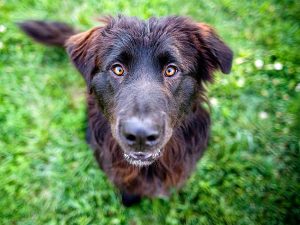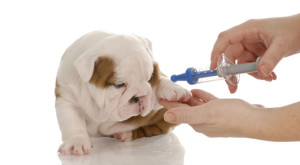Posts Tagged ‘distemper’
New Puppy Checklist: Everything You Need Before Welcoming Your New Furry Friend into Your Life
 Bringing a new puppy into your home is an exciting time but requires some preparation for your home. Puppies require a lot of attention and care, so this checklist will be beneficial if you are unsure where to start with the basics for your new puppy.
Bringing a new puppy into your home is an exciting time but requires some preparation for your home. Puppies require a lot of attention and care, so this checklist will be beneficial if you are unsure where to start with the basics for your new puppy.
Some companies have created puppy starter kits. For example, this box made by Chewy has a set of toys, treats, and potty-training materials to help you with your new puppy. All top-rated items, new puppy owners are sure to appreciate it. It also makes a great gift. It can be found here.
Beyond toys, treats, and potty-training materials, puppies need food and water bowls. There are a lot of different options, but one that is slightly lifted is easier for your puppy to eat from. If you get one with walls, it is more likely your floor will stay cleaner.
Also necessary is a bed for your pet. An elevated bed is good for keeping your dog lifted and is helpful for teaching different cues. Other more traditional options are great too, especially as your pups are growing quickly.
Some owners choose to crate their puppies, and there are a lot of options but must be replaced as dogs grow. Crates help dogs have a safe place, especially as they adjust to a new space and lifestyle.
Also important for your new puppy is a leash. There are many kinds of leashes, with different uses. It will most likely be trial and error to find what works for you and your puppy, so be prepared for a trial period.
Puppies require hygiene efforts. This includes toothbrushes, toothpaste, nail clippers, brushes, and bathing supplies. Providing exposure to these items while young makes it less scary for adult dogs and easier for their owners.
Lastly, a collar is a great way to express your and your pet’s personality. Be prepared for your new pup with a collar and tag to provide some protection and peace of mind.
The last step for a new puppy is establishing an appointment with your veterinarian to get started on vaccinations and discuss your new dog’s life! Feel free to contact Dr. Olsen of Olsen Veterinary Clinic at 618-656-5868 to set up an appointment or discuss any questions!
Tips For Socializing Your Dog
 Socializing your dog teaches them how to react to the world around them healthily without any unnecessary fear or aggression. It is important to start socialization early, so it becomes their normal behavior. Ideally, it should be between three and 12 weeks of age, but not everyone is with their furry friend at that point in their life. Beyond 18 weeks, socialization gets a lot harder, but it is not impossible.
Socializing your dog teaches them how to react to the world around them healthily without any unnecessary fear or aggression. It is important to start socialization early, so it becomes their normal behavior. Ideally, it should be between three and 12 weeks of age, but not everyone is with their furry friend at that point in their life. Beyond 18 weeks, socialization gets a lot harder, but it is not impossible.
An important first step is to take your dog out on daily walks in public. This allows your dog to be exposed to many different experiences such as cars, other dogs, and strangers. The world becomes less scary after a few trips outside. Keep them on a short leash and take your dog on different routes to expose them to new sights and smells. Typically, new puppies should be exposed to different places, bodies of water, woods, beaches, and common neighborhood objects like street signs, bikes, strollers, skateboards, and benches.
Related, expose your dog to a wide variety of people such as men, women, and children so that they can get acclimated to the idea of people other than its owners. If your dog isn’t exposed to people other than its owners, it could become wary of anyone who isn’t their owner, so it is crucial to diversify whom your dog interacts with. Included in socialization is allowing your dog to meet unfamiliar people in unfamiliar clothes like hoods, jackets, sunglasses, and hats.
If your dog acts scared, stay calm and confident. Don’t push them, but don’t make a big deal out of their scared behavior. Use treats to give your dog a positive association with new people and experiences.
Socializing your dog allows them to enjoy the world around them and new experiences. To help your dog not fear new surroundings and people, start early, and show them all that your area has to offer! If you have any questions, feel free to contact Dr. Olsen at Olsen Veterinary Clinic at 618-656-5868.
How To Protect Your Pet From The Heat
 Protecting your pet from the heat is extremely important. As temperatures rise, it becomes more and more uncomfortable to be outside. This is true for your dog as well. During the summer, it is healthier for your dog if you limit outside time, time in dog parks, and exercise to cooler parts of the day, such as morning and evening times. It is not always the temperature as well. The humidity can cause your dog to have difficulty panting. Panting helps your dog cool itself off. Without being able to pant, your dog’s temperature can rise that can lead to heatstroke. If your dog is exhibiting any of the signs of overheating (heavy panting, heavy drooling, trouble breathing, rapid heartbeat, dark or red gums and tongue, dizziness, and weakness, or agitation), be sure to bring your dog to the vet right away. To avoid overheating, there are multiple things that you can do to keep your puppy cool during the hot summer.
Protecting your pet from the heat is extremely important. As temperatures rise, it becomes more and more uncomfortable to be outside. This is true for your dog as well. During the summer, it is healthier for your dog if you limit outside time, time in dog parks, and exercise to cooler parts of the day, such as morning and evening times. It is not always the temperature as well. The humidity can cause your dog to have difficulty panting. Panting helps your dog cool itself off. Without being able to pant, your dog’s temperature can rise that can lead to heatstroke. If your dog is exhibiting any of the signs of overheating (heavy panting, heavy drooling, trouble breathing, rapid heartbeat, dark or red gums and tongue, dizziness, and weakness, or agitation), be sure to bring your dog to the vet right away. To avoid overheating, there are multiple things that you can do to keep your puppy cool during the hot summer.
To begin, make sure to keep your dog groomed, especially if they have long fur. Each breed has different needs. For example, dogs with short, thin coats handle heat better than cold weather and mountain dogs. No dog is immune to heatstroke or paw pad burns, so it’s important to keep your dog groomed. If you get any mats and tangles out of their fur, it will help keep them cool. However, don’t shave or clip their coat until you talk to your vet or groomer. The extra fur that helps your dog stay warm in the winter may also keep it cool in the summer. To keep your dog’s paw pads safe, stick to shaded areas or bring insulation booties to protect your dog’s feet from the hot pavement. To test the heat of the pavement, feel it with the back of your hand. If it is too hot for you, then it is definitely too hot for your dog.
Similarly, be sure to keep your dog’s shots up to date, especially in the summer. The parvovirus spreads in hot weather. During the summer, your dog probably spends more time outside which means that it could come in contact with an animal that has rabies. Summer is also a high season for fleas and mosquitos, both which carry many diseases. By giving your dog medication to prevent these pests, your dog will be safer in the long run.
This should go without saying but leave your pet at home unless your destination is pet friendly. Do not leave your pet in your car. Even with the windows of your car cracked, the temperature inside the car rises rapidly in the summer heat. Similarly, keep your dog’s water supply full. Be sure that there are multiple bowls available for your dog that are always filled with fresh water that is clean. Even if you think that the walk you are going on will be short, be sure to bring clean drinking water and a dish that your dog can easily drink from. If you are worried that your pet is not drinking enough water, add some ice cubes to the bowl. It will make drinking water more appealing to dogs.
When you are spending days outside by a pool or a lake, you can do many things to keep your dog cool while you enjoy the summer sun. You can freeze containers of water so that they will stay cooler for longer. Be sure to keep their water in the shade. You can also provide a small kiddie pool or a sprinkler for your dog to play in. These allow fun places for your dog to cool off and maybe even get some exercise. Similarly, you could put a pet-friendly dig area for your dog in your yard. These can include a sandbox area that your dogs are able to dig in. Dogs often dig a hole to sit in and keep cool. To make an even cooler area, you can spray sand with your cold water. Be sure to make sure that it is located in the shade and not in the sun.
Sometimes, a little extra help is needed to cool your dog. Dog cooling mats and cooling vests are great products. Many work by soaking them in cool water for a long time. If you don’t have access to these, you can soak a towel in cool water and let your dog lie on it. You can also spray your dog’s belly and paws to cool them down. Dogs will cool down more quickly through their belly and paws than water sprayed on their back. Another great DIY to keep your dog cool is to put a pan of ice water in front of the fan to make it more effective for your pup to stay cool.
There are many similar DIYs to keep your pet cool in the summer. Dog-Safe ice cream exists, and you can make it at home. Here is a big list of easy to make ice creams that won’t cost an arm and a leg unlike the gourmet pet store ice-creams. You can also make some frozen treats to put in your dog’s favorite toy. Kong toys come in all shapes and sizes because all dogs love them. They are tough rubber chew toys that are meant to be filled with yummy sticky treats like peanut butter to keep your dog occupied for a while. There are pet-friendly recipes available that are meant to be frozen to keep your dog refreshed while they lick the center. Similar to the Kong treats, you can freeze your dog’s favorite treats in a popsicle mold and fill it with water. It will give your dog a fun treat to keep them cold.
The summer gives many fun opportunities for you and your family. You wouldn’t allow a member of your family to overheat, so don’t let your dog (a furry family member). By following the simple rules of pet care and making some fun treats that your dog will enjoy, you and your dog can have a healthy and cool summer! Make sure to contact our office if you have any questions!
Everything You Ever Wanted To Know About Pet Vaccines
 Pet vaccines are important, and they have a long history. Probably the most important technological gains were discovered in the 1790’s by Dr. Edward Jenner. He discovered the first vaccination by giving people a preparation of material from cowpox, which was a common animal disease in cattle. The people that were injected with or “vaccinated” with the material did not get sick and remained healthy when they were exposed to the deadly smallpox virus. Over 100 years later, a French scientist by the name of Louis Pastuer, found that they could protect people and animals from disease by injecting altered forms of microorganisms.
Pet vaccines are important, and they have a long history. Probably the most important technological gains were discovered in the 1790’s by Dr. Edward Jenner. He discovered the first vaccination by giving people a preparation of material from cowpox, which was a common animal disease in cattle. The people that were injected with or “vaccinated” with the material did not get sick and remained healthy when they were exposed to the deadly smallpox virus. Over 100 years later, a French scientist by the name of Louis Pastuer, found that they could protect people and animals from disease by injecting altered forms of microorganisms.
The process of how a vaccine works is a complex reaction that involves many chemical and cellular reactions within and between the immune system cells of the body. Basically the role of the vaccine is to expose the immune system of the pet to viral and bacterial antigens that are contained in the vaccine. In the future, when the pet is exposed to that related organism, the body will recognize it and then activate the immune system to prevent the disease from producing or reducing the signs of clinical disease.
Vaccines can be administered by subcutaneous or intramuscular injections, intranasal or orally. The vaccines that are injected or given orally tend to produce a more systemic or whole body response, whereas the intranasal provides a more local response. Intranasal vaccines can be advantageous to provide a quicker response and prevent or kill the new virus before it can get any further in the body. Local nasal vaccines would not be helpful for a virus that has been ingested and causes intestinal disease such as parvovirus in dogs. For that we would want a vaccine that would produce a more systemic response.
The vaccines that we use in veterinary medicine are most generally either a killed or a modified live (attenuated) vaccine. There are multiple indications for both, but generally speaking the killed vaccines are safer and unlikely to cause disease in the immunocompromised pet. Whereas, the live vaccines provide a more amplified response that leads to a better, longer lasting immune protection. Several of the vaccines that we use have many different viruses in one injection. This allows to vaccinate for several of the organisms in one injection.
To confuse you even more, pets get some protection through the placenta when the puppies and kittens are in the mother’s uterus and when they get colostrum which is the first milk that they drink. This protection will decrease over time and usually will be low enough by 12 weeks of age where vaccinations will start reacting. There is no way to measure quick, easy and inexpensive way to measure the immunity gained here, so we generally recommend starting vaccines at 6 to 8 weeks of age and then booster them every 2 to 4 weeks until they are 16 weeks of age. Generally, it is not the number of vaccinations that they get, but when they get them at their chronological age.
A vaccine helps prime an animal against a specific disease. It does this by stimulating the immune system with a nonpathogenic virus or bacteria. If the animal responds adequately, it will develop cells that will help it to quickly and efficiently fight off the pathogenic form of the agent if it is encountered later. Here at Olsen Veterinary Clinic, we have tailored our vaccination programs to meet the needs of your pet. If you have any questions please feel free to contact us here, or call our office at 618-656-5868.
Distemper Facts Every Pet Owner Should Know
 Recently you may have read in the news about a distemper outbreak at a St. Louis adoption agency that killed several dogs and puppies. That is terrible news, but most times, distemper can be preventible.
Recently you may have read in the news about a distemper outbreak at a St. Louis adoption agency that killed several dogs and puppies. That is terrible news, but most times, distemper can be preventible.
Distemper is a viral disease that is related to the virus that causes measles in humans. It is spread through all body secretions, especially airborne particles from breathing. This makes it easy for an untreated or unvaccinated dogs to be infected. It appears most often in puppies that are between 6 and 12 weeks who haven’t been vaccinated because the protective antibodies that they had received from their mothers had fallen to a level too low to prevent infection. Not only dogs transfer the infection, but other animals are threats to spread this disease. The most common species that can spread distemper are raccoons, skunks and foxes. Coming into contact with the droppings of these animals can easily spread the disease.
Initially, the disease may present itself with mild symptoms may be mild. These symptoms may include:
- Fever of 103 to 109
- Watery discharge from the eyes and nose
- Depression and listlessness
- Loss of appetite
- Thick, yellow discharge from the eyes and nose
- Dry cough
- Pus blisters on the abdomen
- Vomiting
- Diarrhea
As the disease progresses, it attacks the brain and the symptoms become neurological. Disease progression clinical signs could include:
- Slobbering
- Head shaking
- Chewing jaw motions
- Seizure-like symptoms, such as falling over and kicking feet uncontrollably
- Blindness
- Rhythmic muscle jerking of the head and neck
- Thick, horny skin on the nose and callus-like pads on the feet
If your pet gets distemper, it can’t be cured. Dogs that have progressed to the neurological stage are at a much higher risk of death than if it is caught earlier and treated. Treatment can help the dog mount an immune response better or it may lessen the symptoms of distemper. Since distemper is a virus, the dog’s life relies on the dog’s ability to fight off the disease. Your veterinarian may prescribe antibiotics to prevent secondary infections. He may also give the dog IV fluids to address the dehydration and he may prescribe medications to control diarrhea, vomiting and seizures.
Success of the treatments are largely dependent on the age of the dog, how quickly you seek help, the distemper strain, and whether your dog has been vaccinated. Vaccination against distemper is highly protective.
Some dogs may recover on their own, but owners should never take the wait and see approach with distemper. If your dog recovers from distemper, and that is a big “if”, your dog would be naturally immune to a second attack, just like measles in humans.
I would recommend using caution when socializing puppies or unvaccinated dogs at parks, obedience classes, doggy day care and other places where dogs can congregate since this disease is quite contagious. Make sure that you do not share food or water bowls with other dogs as this can be a common source of infection.
I can’t stress enough how important that your dog should be vaccinated for distemper. This vaccination is usually started when the puppy is 5 to 6 weeks old and continued every 3 to 4 weeks until the puppy is 4 months old. This should provide long lasting immunity. But it is not permanent. If your dog is adopted, ask the facility if and when they had given the distemper vaccine. No dog should ever die of distemper as the vaccinations are quite effective.
With the quality vaccines distemper is very preventible. Keeping your pet current on its’ vaccines is extremely important. If you have any further questions or need your pet vaccinated, please feel free to contact us here or call us at 618-656-5868.
Why Should I Vaccinate My Pet?
“I figured, what’s the worse that could happen? If he got sick, I’d take him to the vet. Well, he got sick. Real sick. It kills me to think about how scared, how weak he looked, and how despondent my kids were. He was the star of the house. And he was gone, just like that.”
Some days in our clinic, we see this. Clients bringing in their lifeless pets for us to treat and nurse their beloved pet back to health. Sometimes this could have been preventable if only they had vaccinated their pet.
If you have paid attention to the media, there is a lot of discussion on whether you should vaccinate your children or not. Unfortunately, this discussion also crops up in veterinary medicine—whether to vaccinate your pet or not.
There are only two reasons to vaccinate. They are to protect your pet and protect the pets and people around us. Cat and dog diseases still exist and can infect any pet that is not protected. You never know when or where your pet can be exposed. Vaccinations are the best way to stimulate the immune system to stop diseases when exposed and for the vast majority of pets, the benefits of vaccinating far outweigh the risks.
We can’t depend on other pet owners to provide the proper vaccinations to their pets so that our pet has less opportunity to get a disease. So by vaccinating we are cooperating will all individuals to reduce the possibility of spreading disease.
There are several reasons that you should vaccinate your pets. The first and foremost is that with some diseases, it is the law. It is mandatory that you have your pet vaccinated against rabies in every U.S. State. Even pets kept indoors can potentially be exposed if the get out unexpectedly or an uninvited animal gets in the house. The important thing about rabies is that humans can get it and it is fatal.
Several diseases can be transmitted from pets to humans such as rabies and Leptospirosis. Vaccinating your pet helps reduce the risk of human infection and is especially necessary if there are young, elderly, or immune-compromised members in your household.
Many people have their pet groomed, boarded, or attend doggy daycare. If you do, most places require that you pet have a vaccine against kennel cough. This disease is a hacking cough that is highly contagious. Although the disease is relatively mild, it can sometime lead to severe pneumonia.
Young unvaccinated puppies are at risk to contracting parvovirus. This is a severe life-threatening infection that causes bloody diarrhea and vomiting to the point of shock and even death. Parvovirus is extremely contagious and puppies are most at risk. This disease is almost 100% preventable with vaccination.
Puppies can get a severe neurological, dermatologic, and respiratory disease called distemper. Most dogs that contract distemper and euthanized due to the progressive nature of the disease. This disease can also be prevented by timely vaccinations.
There are other diseases such as hepatitis, Lyme disease, and Leptospirosis that can be prevented by vaccinating your puppies.
Believe it or not vaccinating can save money. Most veterinary vaccinations are relatively inexpensive. Vaccinations are definitely less expensive that the cost of treatment for the diseases that they protect against.
An ounce of prevention really is worth a pound of cure. Many dangerous diseases seen in dogs and cats are completely preventable with the right vaccinations. Vaccinating gives pet owners peace of mind and helps pets lead safe and healthy lives.
If you have questions, or are still unsure about vaccinations for your pet, contact our office today.

